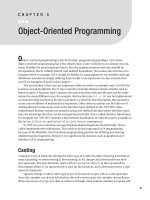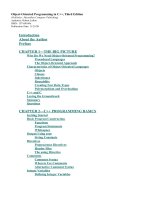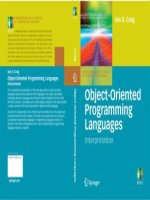Lecture Object oriented programming - Lecture No 29
Bạn đang xem bản rút gọn của tài liệu. Xem và tải ngay bản đầy đủ của tài liệu tại đây (65.51 KB, 14 trang )
CSC241: Object Oriented Programming
Lecture No 29
1
Previous Lecture
•
Exception in Distance class
•
Re-throwing an exception
•
Exception with arguments
•
bad_alloc class
•
set_new_handler function
2
Today’s Lecture
•
Handler function
•
Standard library Exception Hierarchy
•
Example program
–
Queue class using array
–
A linked list data storage class
3
Handler function
•
•
•
•
This function will be called if new fails
This provides a method to handling all new
failure with a uniform approach
set_new_handler function is used to register a
handler function
If new fails to allocate memory, then
–
If handler function is registered then it will be called
–
If handler function is not registered then
4
Cont.
•
•
If new allocates memory successfully, it returns
a pointer to that memory
If new fails to allocate memory, then
–
If set_new_handler did not register a new-handler
function, new throws a bad_alloc exception
–
If a new-handler function has been registered, the
new-handler function is called
5
Task performed by handler-function
1.
2.
3.
Make more memory available by deleting other
dynamically allocated memory and return to
operator new to attempt to allocate memory
again.
Throw an exception of type bad_alloc.
Call function abort or exit to terminate the
program
6
Example
7
Standard Library Exception Hierarchy
8
Summary
•
•
•
•
•
An exception is an indication of a problem that
occurs during a program's execution
Exception handling enables programmers to
create programs that can resolve problems that
occur at execution
Exception handling enables the programmer to
remove error-handling code
try block define a block of code in which
exceptions might occur
At least one catch handler must immediately
follow a try block
9
Cont.
•
•
•
•
catch handler specifies an exception
parameter that represents the type of
exception the catch handler can process
Point in the program at which an exception
occurs is called the throw point
When a try block terminates, local variables
defined in the block go out of scope
Common examples of exceptions are
–
out-of-range array subscripts,
–
arithmetic overflow,
10
Cont.
•
•
Destructors are called for every object
constructed in a try block before an exception is
thrown
If an array of objects has been partially
constructed when an exception occurs, only the
destructors for the constructed array element
objects will be called.
11
Exercise program 1
•
A queue is a data-storage device.
•
Queue principle: first-in-first-out
Write a class template for a queue class. Also
check if the queue is full or empty and throw an
0 1 2 3 4
exception if it is
1 1 1
Insert
a[5]
delete
0 2 4
element
a[++rear] = 10;
element
if (front ==-1)
if(front==-1 || front>rear)
front -1
1
0
•
front ++;
a[++rear] = 12;
a[++rear] = 14;
printf(“%d”, a[front]);
front ++;
1
2
0
rear -1
Go to
program
12
Exercise program 2
•
•
A link list data storage class
It consist of a group of nodes which together
represent a sequence
data ptr
data ptr
data ptr
data ptr
ptr
template
struct Node
{
TYPE data;
Node* next;
};
template<class TYPE>
class linklist {
private:
Node<TYPE>* first;
public:
void additem(TYPE
d);
void display();
Go to
program
13
14









